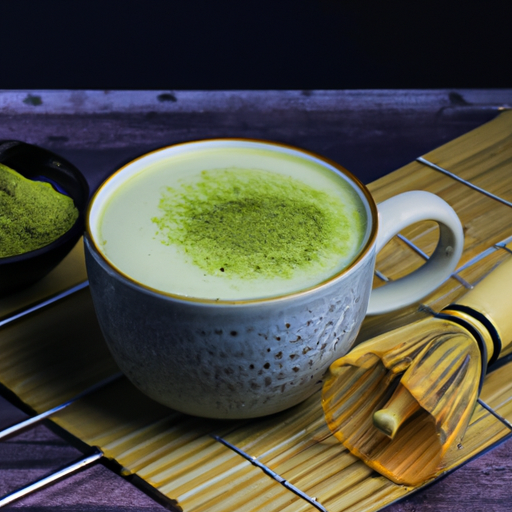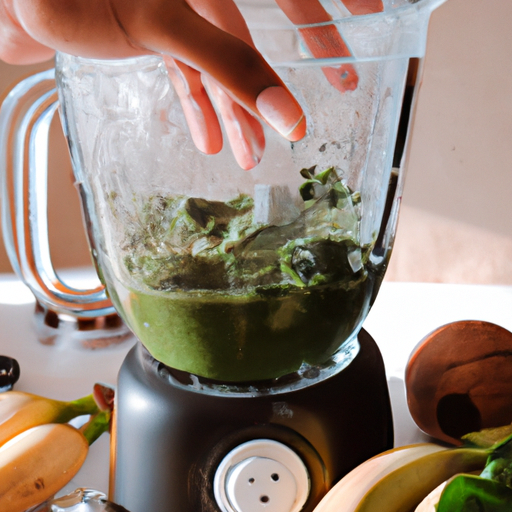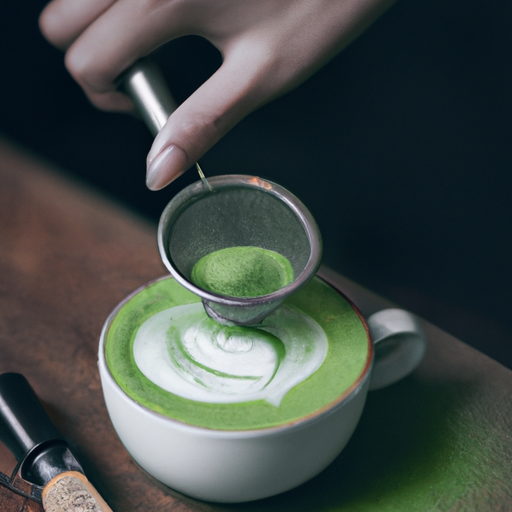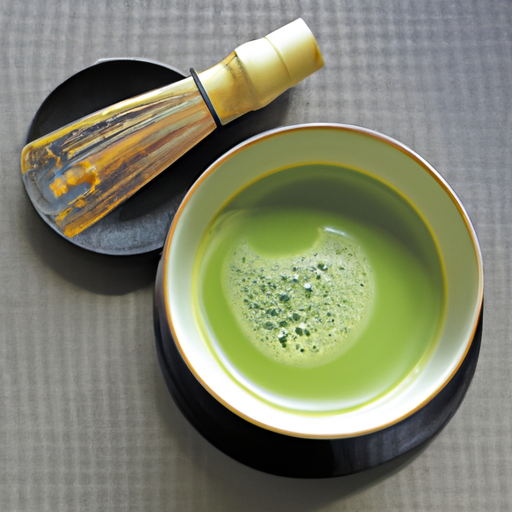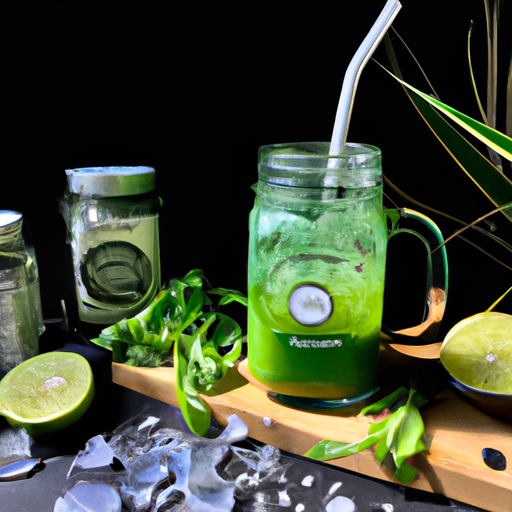Hello, matcha enthusiasts! In this post, I’ll be guiding you through the steps to create a tasty matcha latte using oat milk. This recipe is straightforward and adaptable, allowing you to tweak it according to your taste preferences.
To get started, you’ll need just a few basic ingredients: matcha powder, oat milk (or any plant-based milk of your choice), and sweetener (if desired). With these ingredients on hand, you’ll be able to whip up a creamy and frothy latte in no time.
So let’s get started!
Key Takeaways
- Oat milk is a great alternative for those who are vegan, lactose intolerant, or have nut allergies, and it’s low in fat, cholesterol-free, and rich in fiber and essential vitamins.
- Mixing techniques are crucial for achieving a creamy and frothy matcha latte, and options include using a matcha whisk, frothing wand, or regular whisk/frother.
- Sweeteners like honey or agave can be added for taste, but it’s important not to overpower matcha’s distinct bitter taste.
- Experimenting with different plant-based milk options and toppings like cinnamon or cocoa powder can enhance the flavor profile, and foam can be achieved with a handheld frother or automatic milk frother.
Gather Your Ingredients
Now it’s time for you to gather up all those delicious ingredients and get ready to make the best matcha latte with oat milk you’ve ever tasted!
To start, you’ll need some high-quality matcha powder and oat milk. Oat milk is a great alternative to dairy or soy milk since it has a creamy texture that pairs well with the earthy flavor of matcha. Additionally, oat milk is low in fat, cholesterol-free, and contains essential vitamins like calcium and vitamin D.
Before we proceed further, let me tell you about the benefits of using oat milk in your matcha latte. Apart from being vegan-friendly, oat milk is also an excellent option for people who are lactose intolerant or have nut allergies. It’s also rich in fiber and can help lower cholesterol levels while keeping your heart healthy. If you don’t have any oat milk on hand, feel free to substitute it with other plant-based milks like almond or coconut.
Once you have gathered all the necessary ingredients, it’s time to heat your oat milk on medium heat until it reaches a temperature of 160°F. This step is crucial as overheating can cause the oat milk to curdle or separate from the matcha powder later on. After heating the oat milk, let it cool down for a minute before mixing it with your matcha powder.
Heat Your Oat Milk
To heat my oat milk, I typically use either the stovetop or microwave method.
For the stovetop method, I pour the desired amount of oat milk into a small pot and place it over medium heat. I then whisk the milk continuously until it begins to steam and small bubbles form on the surface.
Alternatively, for the microwave method, I pour the oat milk into a microwave-safe container and heat on high for 30-second intervals until it reaches my desired temperature.
Stovetop method
First, you’ll need to heat up your oat milk on the stove for a creamy base to your matcha latte. Using the stovetop method is an efficient way to heat up your plant-based milk alternatives such as oat milk. Here’s how:
- Pour desired amount of oat milk into a small saucepan.
- Heat the pan over medium-low heat, stirring occasionally with a whisk or spoon.
- Once the milk is heated through and steamy, remove the pan from heat.
Now that you have hot and frothy oat milk, it’s time to move on to making your matcha latte using either the microwave method or frothing wand method.
Microwave method
Once the oat milk’s heated on the stovetop, it’s time to quickly and easily finish off your creamy matcha latte using the microwave method.
This technique is a great option for those looking for microwave efficiency and convenience.
Simply transfer the hot oat milk into a mug and add in your desired amount of matcha powder and sweetener.
Then, use a handheld frother or whisk to mix everything together until well combined.
If you don’t have a frother or prefer alternative methods, you can also achieve frothiness by shaking the mixture vigorously in a closed container like a mason jar for about 30 seconds before microwaving it for another 30-45 seconds.
Be sure to keep an eye on your latte while it’s in the microwave as oat milk has been known to foam up quickly when heated excessively.
Once done, give your latte one final stir and enjoy!
Now that your latte is ready, let’s move onto how to whisk your matcha powder for optimal results.
Whisk Your Matcha Powder
To whisk my matcha powder, I typically use a matcha whisk made specifically for this purpose. It has thin and flexible bristles that help evenly distribute the powder in the water without clumping.
However, if a matcha whisk isn’t available, a regular whisk or frother can also be used to create a similar effect. Just make sure to mix the powder thoroughly with whichever tool you choose before adding any other ingredients to your drink.
Use a matcha whisk
Whisking matcha with oat milk is the key to achieving a frothy latte that’s both creamy and delicious. But not just any whisk will do – using a matcha whisk has its benefits over a regular whisk.
The main difference between a matcha whisk and a regular whisk is the number of prongs. A matcha whisk, also known as a chasen, has many thin prongs that are specifically designed to break up clumps of matcha powder and create a fine foam. In contrast, a regular whisk typically has thicker prongs that may not be as effective in creating the desired texture for your latte.
| Matcha Whisk | Regular Whisk |
|---|---|
| Many thin prongs | Thicker prongs |
| Specifically designed for breaking up clumps of matcha powder | Not specifically designed for matcha lattes |
| Creates fine foam | May not produce desired texture |
While it is possible to use a regular whisk or even an electric frother to make your latte, using a matcha whisk can elevate the experience by producing the perfect balance of creamy and foamy textures in your drink. However, if you don’t have access to one, don’t worry – there are still other ways to achieve similar results.
Use a regular whisk or frother
Using a matcha whisk to mix your matcha latte may seem like the most authentic way to prepare it, but not everyone has this tool on hand. Don’t worry, you can still make a delicious matcha latte with oat milk using a regular whisk or frother.
One advantage of using a regular whisk is that it’s more easily accessible and doesn’t require any special equipment. It also allows you to have more control over the mixing process and can create a smoother texture if done correctly.
On the other hand, using a frother can save time and effort as it creates foam quickly and effortlessly. However, some frothers may not be compatible with thicker liquids like oat milk and may produce less foam compared to others.
To use a regular whisk, simply add hot water to your matcha powder and stir vigorously until there are no clumps left before adding oat milk.
To use a frother, heat up your oat milk first before pouring into the matcha mixture in an electric frother.
Now that we’ve covered how to mix your ingredients without using a matcha whisk, let’s move on to our next step – adding sweetener (optional).
Add Sweetener (Optional)
If you’re looking to indulge your sweet tooth, go ahead and add a touch of honey or agave to your matcha latte with oat milk – it’s the perfect finishing touch! Not only will it satisfy your cravings, but adding a sweetener can also enhance the overall flavor profile of your matcha latte. There are plenty of sweetener options out there, so you can choose one that fits your taste preferences.
When it comes to health benefits, honey is known for its antibacterial and anti-inflammatory properties. Agave nectar is a low-glycemic index sweetener which means it won’t cause spikes in blood sugar levels. Additionally, both honey and agave contain antioxidants which help protect against cell damage caused by free radicals.
To make sure you’re using the right amount of sweetener for your matcha latte with oat milk, refer to this table:
| Sweetener | Serving Size | Calories |
|---|---|---|
| Honey | 1 teaspoon | 21 |
| Agave Nectar | 1 teaspoon | 20 |
Now that you’ve decided on a sweetener option and serving size, it’s time to combine the matcha powder and oat milk.
Combine Matcha and Oat Milk
Now that we’ve added sweetener to our matcha latte, it’s time to combine the matcha powder and oat milk together. This is where the magic happens and the delicious beverage comes to life.
Before we get started, let’s talk about some of the benefits of a matcha latte. Matcha is high in antioxidants and provides a natural source of energy without any crashes or jitters. It also boosts metabolism and supports immune health. When combined with oat milk, which is a great alternative for those who’re lactose intolerant or vegan, this drink becomes even more nutritious.
To begin, add your desired amount of matcha powder into a mug or cup. Next, slowly pour in heated oat milk while whisking vigorously until well combined and frothy. You can use a traditional bamboo whisk or an electric frother for this step, depending on your preference.
Now that our matcha powder and oat milk are perfectly mixed together, it’s time to move on to the final step of enjoying our delicious matcha latte – mixing everything well!
Mix Well
Once the matcha powder and oat milk are combined, don’t forget to give it a good mix to ensure every sip is filled with creamy goodness. Mixing is crucial in making matcha lattes as it allows for even distribution of the powder and milk, resulting in a smoother texture. The last thing you want is clumps of undissolved matcha in your latte.
To achieve perfect foam in your latte, heat the oat milk until it’s hot but not boiling. Then, use a handheld frother or blender to create froth before pouring it into the matcha mixture. This method ensures that the foam stays on top and doesn’t sink down to the bottom.
Now that you’ve mixed everything well and achieved perfect foam, adjust to taste by adding sweeteners like honey or sugar if desired. Remember that matcha has a distinct bitter taste, so adding too much sweetness can overpower its flavor.
With these tricks up your sleeve, you’ll be able to make an impeccable matcha latte with oat milk every time!
Adjust to Taste
To perfect the flavor of your matcha latte with oat milk, it’s important to adjust it to your taste preferences. While some people may enjoy the distinct bitterness of matcha, others might find it too overpowering.
You can adjust the flavor by adding a touch of sweetness with honey or sugar. However, you should be mindful not to add too much sweetness as it can mask the unique taste of matcha.
To achieve a perfectly balanced matcha latte with oat milk, start by adding a small amount of sweetener and gradually increase until you reach your desired level of sweetness. Additionally, you can experiment with different types of sweeteners such as agave syrup or stevia for a healthier option.
Another adjustment tip is to vary the amount of oat milk used in your recipe according to how creamy or light you prefer your latte.
Once you have adjusted the flavor and consistency to your liking, it’s time to pour your matcha latte into a mug and enjoy!
Pour into a Mug
Pour the perfectly blended, velvety matcha oat milk latte into a favorite mug and savor every sip. As you pour, take note of the beautiful green color of the latte and notice how it contrasts with your mug.
If you want to add toppings, now’s the time! Sprinkle some cinnamon or cocoa powder on top of the foam for an extra flavor boost. If you prefer alternative milk options, feel free to experiment with different types of plant-based milk such as almond or coconut milk.
Each type of milk has its own unique taste and texture that can enhance or change the overall flavor profile of your latte. However, keep in mind that some milks may not blend as well as others and may affect the consistency of your latte.
Now that your matcha oat milk latte is poured into a mug, it’s time to move onto the next step: adding foam (optional). But before we do that, take a moment to appreciate how easy it was to make this delicious drink in just a few simple steps. With a little practice and experimentation with different toppings and alternative milks, you can customize your matcha oat milk latte to suit your personal taste preferences.
Add Foam (Optional)
As you prepare for the final touches, take your frother and create a layer of creamy foam to top off your velvety green drink. Foam is an optional addition that adds a barista-worthy touch to your matcha latte.
To create a perfect foam, choose plant-based milk alternatives like oat milk which offer a creamier texture than regular dairy milk. Foam techniques can vary depending on personal preference and equipment available.
A simple way to make foam is by heating up the oat milk in a saucepan until it starts steaming. Then, use a handheld electric frother or whisk to vigorously mix the heated milk until it becomes frothy and thick. Another method involves using an automatic milk frother that heats and froths at the same time.
Once you’ve achieved the desired level of foam, gently pour it over your matcha latte’s surface, ensuring even distribution across the mug. The resulting creamy topping not only looks great but also adds another dimension of flavor to your matcha latte with oat milk.
Now you’re all set to enjoy your matcha latte with oat milk! Sip away while savoring the rich taste of green tea blended with velvety smoothness from oat milk foam – truly a satisfying sip any time of day!
Enjoy Your Matcha Latte with Oat Milk!
I hope you enjoyed adding foam to your matcha latte because now it’s time to enjoy the final product! In this current subtopic, I’ll walk you through the benefits of using oat milk and the different types of matcha powder you can use to make your perfect matcha latte.
Firstly, let’s talk about oat milk. Not only is it a great dairy-free alternative for those with lactose intolerance or vegan diets, but it also has plenty of benefits. Oat milk is high in fiber and protein, which helps keep you feeling full longer. It also contains beta-glucans that can help lower cholesterol levels and improve heart health. Plus, it has a mild taste that won’t overpower the delicate flavor of matcha.
Now onto the type of matcha powder to use for your latte. There are two main types: ceremonial grade and culinary grade. Ceremonial grade is made from young tea leaves and has a smoother texture with a more delicate flavor profile. This type is best used for traditional tea ceremonies or when making a plain cup of matcha without any added sweeteners or flavors.
Culinary grade, on the other hand, is made from older tea leaves and has a slightly bitter taste that works well in desserts or drinks with added flavors like honey or vanilla.
To summarize, using oat milk as an alternative to dairy in your matcha latte not only provides health benefits but also maintains the integrity of the drink’s unique flavor profile. Additionally, choosing between ceremonial and culinary grade will depend on personal preference and what kind of latte you’re looking to make – whether plain or flavored with additional ingredients such as honey or vanilla extract.
Frequently Asked Questions
What other types of milk can be used besides oat milk?
Did you know that over 65% of people in the United States are lactose intolerant? This means that many individuals are seeking alternatives to dairy milk.
Almond milk is a popular alternative, with its creamy texture and nutty taste. Soy milk is also a great option, as it is high in protein and has a mild flavor. Both types of milk can be used as substitutes for oat milk when making a matcha latte.
It’s important to note that each type of milk will affect the taste and texture of the latte differently, so it’s best to experiment and find which one you prefer.
Overall, there are plenty of delicious alternatives to oat milk for those who want to enjoy a tasty matcha latte without dairy!
Is matcha powder expensive and where can it be purchased?
When it comes to matcha powder, the price can vary depending on the quality and brand. However, it’s generally more expensive than regular tea due to the labor-intensive process involved in producing high-quality matcha.
You can find matcha powder at specialty tea shops, health food stores, or online retailers like Amazon. It’s important to read reviews and check for certifications to ensure you’re getting a quality product.
In terms of matcha latte variations, there are many ways to customize your drink. Some people prefer a traditional latte with milk and sweetener, while others opt for non-dairy alternatives like almond or oat milk.
You can also add flavors like vanilla extract or honey for extra sweetness. Experiment with different ratios of milk to matcha powder until you find your preferred taste and consistency.
Can honey be used as a sweetener instead of sugar?
Honey vs sugar as sweetener is a hotly debated topic in the culinary world. As someone who loves exploring different taste preferences, I’ve tried both and found that honey adds a unique flavor profile to any dish.
However, when it comes to health benefits, honey may not always be the best option due to its high fructose content. On the other hand, sugar may not be as flavorful but it’s much easier for our bodies to break down and digest.
Ultimately, the decision between these two sweeteners depends on personal preference and health goals.
Are there any health benefits to drinking matcha lattes with oat milk?
There are definitely some health benefits to drinking matcha lattes with oat milk.
Oat milk is a great alternative to other types of milk because it’s naturally lower in fat and calories, but still provides a good source of nutrients like calcium and vitamin D.
Additionally, oat milk contains soluble fiber which can help reduce cholesterol levels and improve heart health.
When compared to other plant-based milk alternatives like almond or soy milk, oat milk also tends to have more protein and less sugar.
By choosing oat milk as the base for your matcha latte, you’re not only getting a delicious coffee shop-style drink but also reaping some nutritional benefits that can support overall health and wellbeing.
Can the recipe be adjusted to make a larger or smaller serving?
When it comes to making matcha lattes with oat milk, adjusting the serving size and recipe variations are easily achievable.
The first thing to consider is the desired serving size. If you want a larger or smaller serving, simply adjust the amount of ingredients accordingly. For example, if you want a larger serving, use more oat milk and matcha powder than what’s called for in the original recipe. On the other hand, if you want a smaller serving, reduce the amount of these ingredients proportionally.
As for recipe variations, there are many ways to customize your matcha latte with oat milk based on personal preferences. You can add sweeteners like honey or maple syrup for a touch of sweetness or experiment with different types of milk such as almond or coconut milk for added flavor complexity. The possibilities are endless!
Conclusion
In conclusion, making a matcha latte with oat milk is easy and can be done in just a few simple steps. The combination of the earthy matcha powder and creamy oat milk creates a delicious drink that is both satisfying and healthy.
Whether you’re looking for a new coffee alternative or simply want to try something new, this recipe is definitely worth giving a shot. On one hand, the process might seem daunting at first, but with practice it becomes second nature.
On the other hand, once you’ve mastered this technique, you’ll have the ability to make your own delicious and nutritious matcha lattes without having to leave your home. So why not give it a try? With just a few ingredients and some patience, you’ll be able to whip up your very own matcha latte with oat milk in no time!

